ICT103: System Analysis and Design Report for QuickCabs
VerifiedAdded on 2022/11/22
|18
|2607
|110
Report
AI Summary
This report provides a comprehensive system analysis and design for the QuickCabs online taxi booking system. It begins with an introduction outlining the system's purpose and functionalities, followed by a discussion of the Waterfall methodology, which is deemed suitable for the project. The report then details the requirement gathering process, distinguishing between functional and non-functional requirements. Requirement modeling is extensively covered, with the inclusion of various UML diagrams such as use case diagrams, activity diagrams, domain model class diagrams, sequence diagrams, and state machine diagrams, along with a user interface diagram to visually represent the system's design. The functional requirements include user account management, booking options, payment processing, and time zone synchronization, while non-functional requirements emphasize security, performance, and user-friendliness. The report also provides class diagrams to represent the different components of the QuickCabs system. The report concludes by emphasizing the benefits of the online taxi booking system, including improved efficiency, customer satisfaction, and business growth. References to relevant literature are provided at the end.
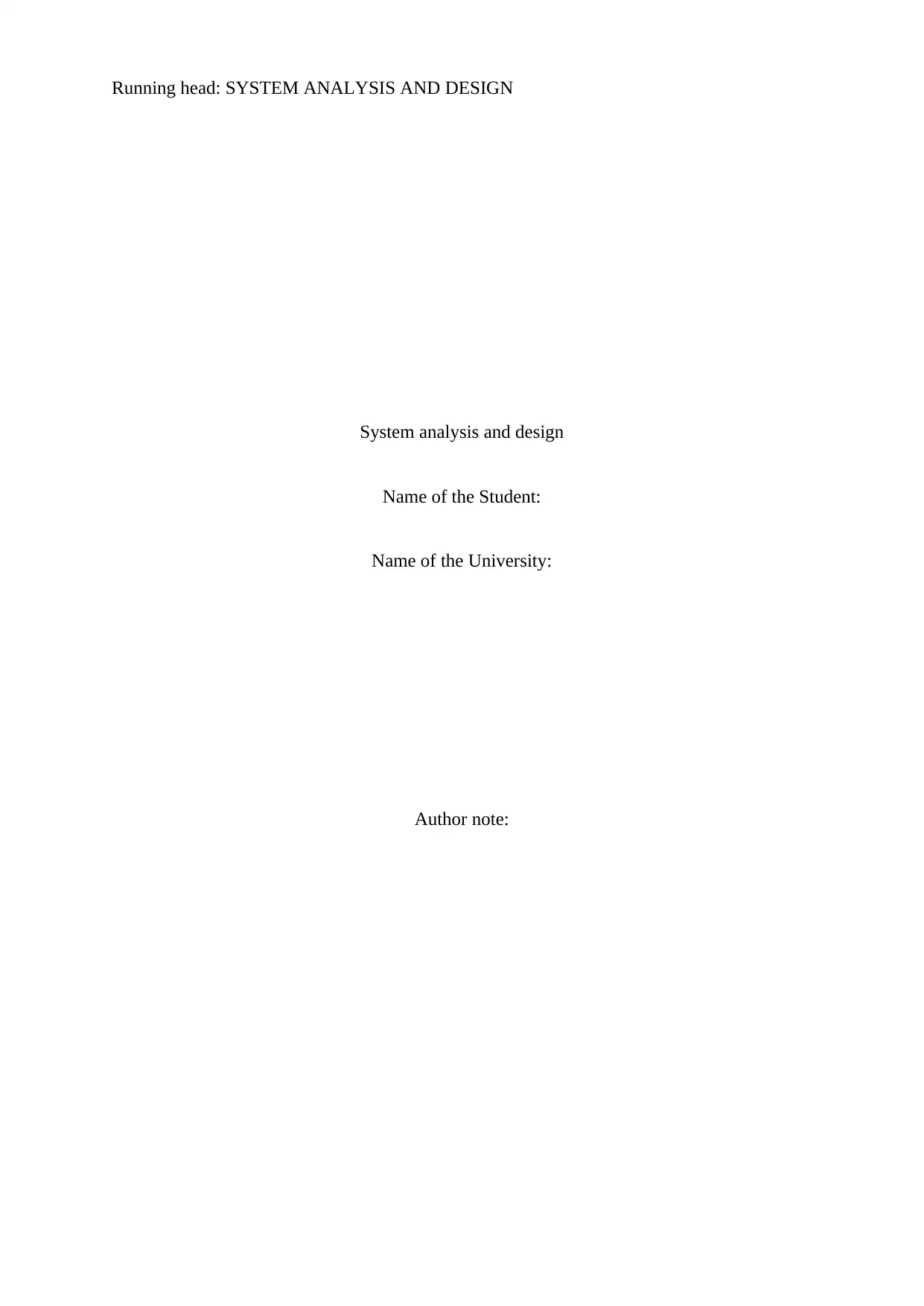
Running head: SYSTEM ANALYSIS AND DESIGN
System analysis and design
Name of the Student:
Name of the University:
Author note:
System analysis and design
Name of the Student:
Name of the University:
Author note:
Paraphrase This Document
Need a fresh take? Get an instant paraphrase of this document with our AI Paraphraser
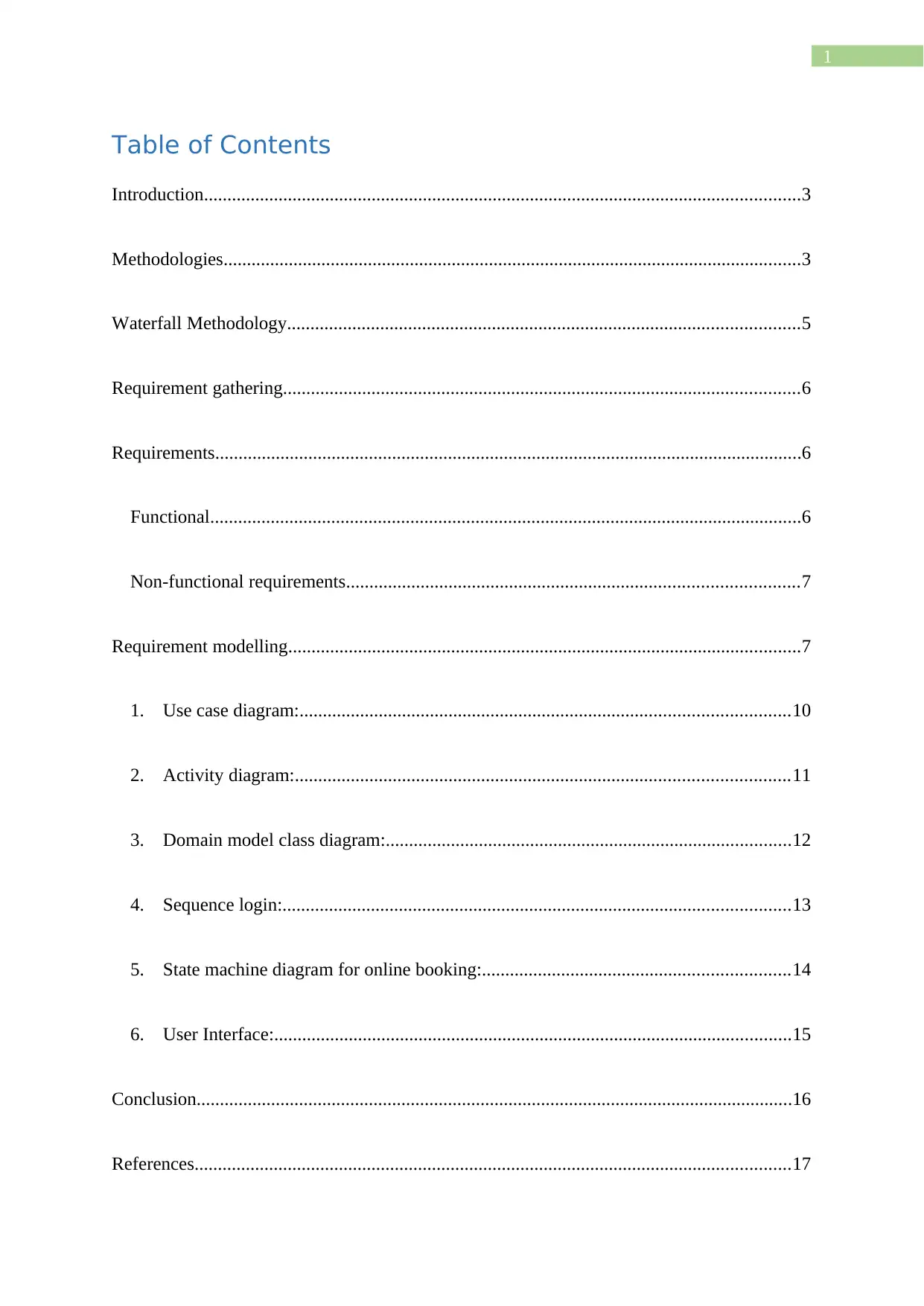
1
Table of Contents
Introduction................................................................................................................................3
Methodologies............................................................................................................................3
Waterfall Methodology..............................................................................................................5
Requirement gathering...............................................................................................................6
Requirements..............................................................................................................................6
Functional...............................................................................................................................6
Non-functional requirements.................................................................................................7
Requirement modelling..............................................................................................................7
1. Use case diagram:.........................................................................................................10
2. Activity diagram:..........................................................................................................11
3. Domain model class diagram:.......................................................................................12
4. Sequence login:.............................................................................................................13
5. State machine diagram for online booking:..................................................................14
6. User Interface:...............................................................................................................15
Conclusion................................................................................................................................16
References................................................................................................................................17
Table of Contents
Introduction................................................................................................................................3
Methodologies............................................................................................................................3
Waterfall Methodology..............................................................................................................5
Requirement gathering...............................................................................................................6
Requirements..............................................................................................................................6
Functional...............................................................................................................................6
Non-functional requirements.................................................................................................7
Requirement modelling..............................................................................................................7
1. Use case diagram:.........................................................................................................10
2. Activity diagram:..........................................................................................................11
3. Domain model class diagram:.......................................................................................12
4. Sequence login:.............................................................................................................13
5. State machine diagram for online booking:..................................................................14
6. User Interface:...............................................................................................................15
Conclusion................................................................................................................................16
References................................................................................................................................17
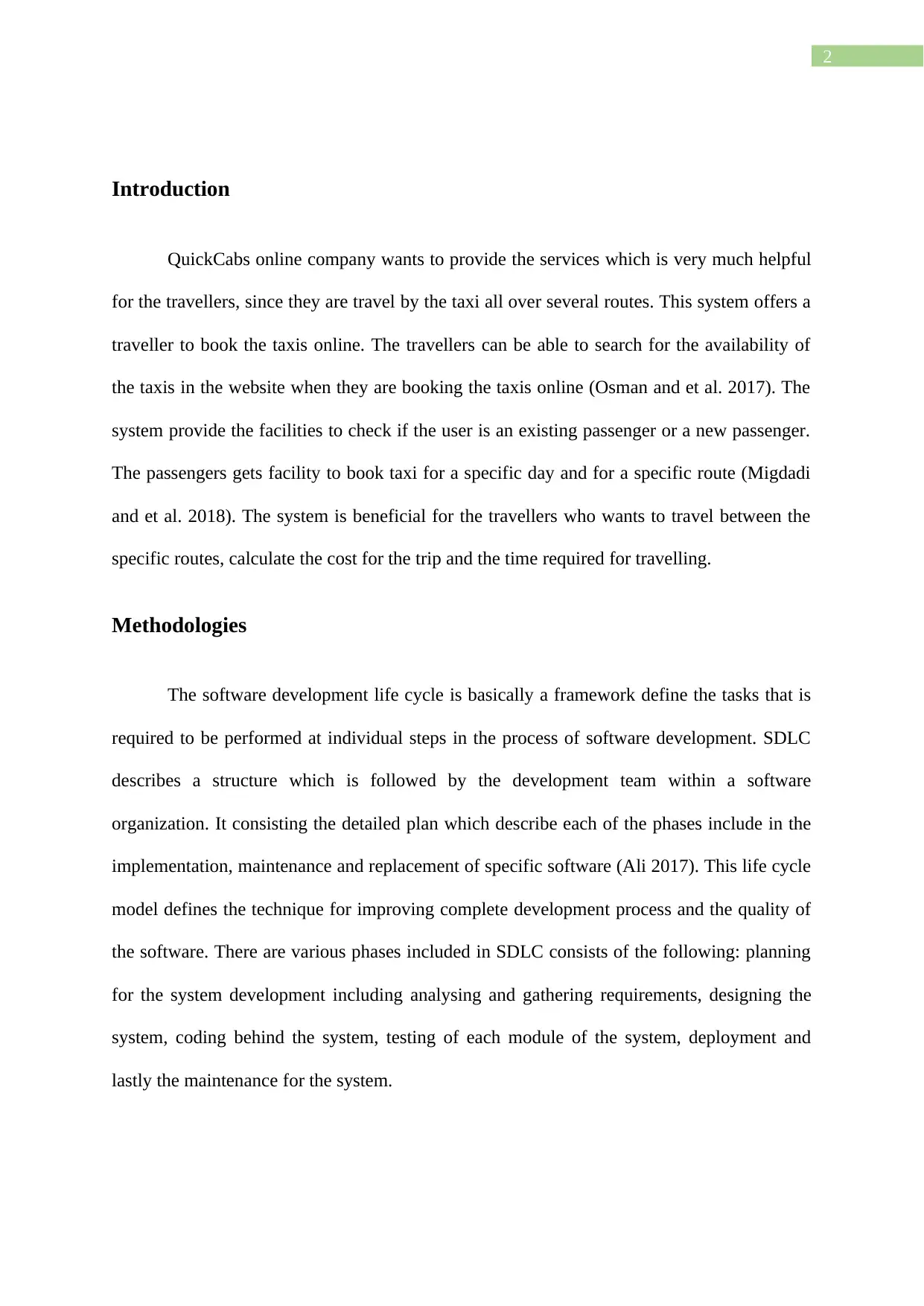
2
Introduction
QuickCabs online company wants to provide the services which is very much helpful
for the travellers, since they are travel by the taxi all over several routes. This system offers a
traveller to book the taxis online. The travellers can be able to search for the availability of
the taxis in the website when they are booking the taxis online (Osman and et al. 2017). The
system provide the facilities to check if the user is an existing passenger or a new passenger.
The passengers gets facility to book taxi for a specific day and for a specific route (Migdadi
and et al. 2018). The system is beneficial for the travellers who wants to travel between the
specific routes, calculate the cost for the trip and the time required for travelling.
Methodologies
The software development life cycle is basically a framework define the tasks that is
required to be performed at individual steps in the process of software development. SDLC
describes a structure which is followed by the development team within a software
organization. It consisting the detailed plan which describe each of the phases include in the
implementation, maintenance and replacement of specific software (Ali 2017). This life cycle
model defines the technique for improving complete development process and the quality of
the software. There are various phases included in SDLC consists of the following: planning
for the system development including analysing and gathering requirements, designing the
system, coding behind the system, testing of each module of the system, deployment and
lastly the maintenance for the system.
Introduction
QuickCabs online company wants to provide the services which is very much helpful
for the travellers, since they are travel by the taxi all over several routes. This system offers a
traveller to book the taxis online. The travellers can be able to search for the availability of
the taxis in the website when they are booking the taxis online (Osman and et al. 2017). The
system provide the facilities to check if the user is an existing passenger or a new passenger.
The passengers gets facility to book taxi for a specific day and for a specific route (Migdadi
and et al. 2018). The system is beneficial for the travellers who wants to travel between the
specific routes, calculate the cost for the trip and the time required for travelling.
Methodologies
The software development life cycle is basically a framework define the tasks that is
required to be performed at individual steps in the process of software development. SDLC
describes a structure which is followed by the development team within a software
organization. It consisting the detailed plan which describe each of the phases include in the
implementation, maintenance and replacement of specific software (Ali 2017). This life cycle
model defines the technique for improving complete development process and the quality of
the software. There are various phases included in SDLC consists of the following: planning
for the system development including analysing and gathering requirements, designing the
system, coding behind the system, testing of each module of the system, deployment and
lastly the maintenance for the system.
⊘ This is a preview!⊘
Do you want full access?
Subscribe today to unlock all pages.

Trusted by 1+ million students worldwide
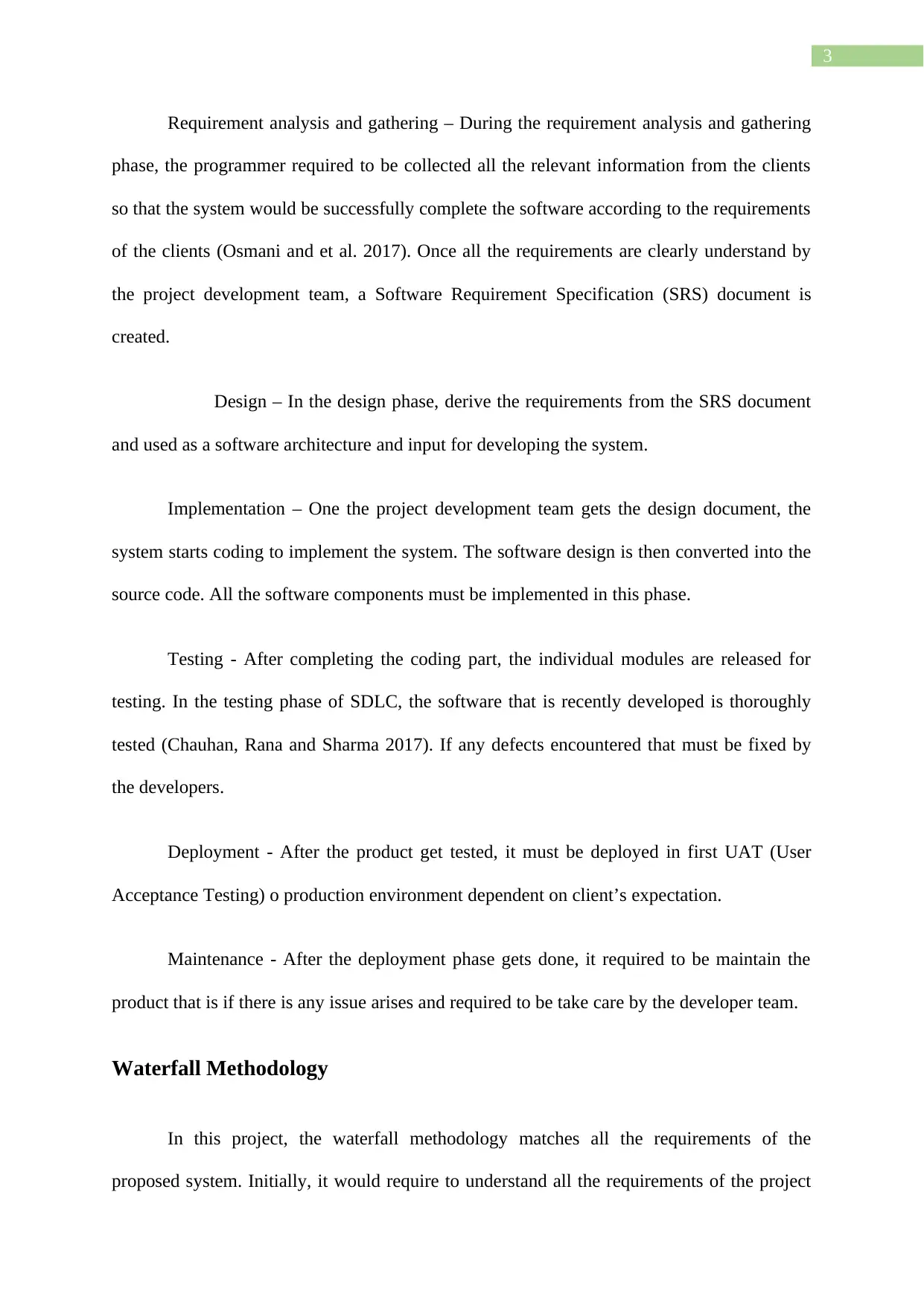
3
Requirement analysis and gathering – During the requirement analysis and gathering
phase, the programmer required to be collected all the relevant information from the clients
so that the system would be successfully complete the software according to the requirements
of the clients (Osmani and et al. 2017). Once all the requirements are clearly understand by
the project development team, a Software Requirement Specification (SRS) document is
created.
Design – In the design phase, derive the requirements from the SRS document
and used as a software architecture and input for developing the system.
Implementation – One the project development team gets the design document, the
system starts coding to implement the system. The software design is then converted into the
source code. All the software components must be implemented in this phase.
Testing - After completing the coding part, the individual modules are released for
testing. In the testing phase of SDLC, the software that is recently developed is thoroughly
tested (Chauhan, Rana and Sharma 2017). If any defects encountered that must be fixed by
the developers.
Deployment - After the product get tested, it must be deployed in first UAT (User
Acceptance Testing) o production environment dependent on client’s expectation.
Maintenance - After the deployment phase gets done, it required to be maintain the
product that is if there is any issue arises and required to be take care by the developer team.
Waterfall Methodology
In this project, the waterfall methodology matches all the requirements of the
proposed system. Initially, it would require to understand all the requirements of the project
Requirement analysis and gathering – During the requirement analysis and gathering
phase, the programmer required to be collected all the relevant information from the clients
so that the system would be successfully complete the software according to the requirements
of the clients (Osmani and et al. 2017). Once all the requirements are clearly understand by
the project development team, a Software Requirement Specification (SRS) document is
created.
Design – In the design phase, derive the requirements from the SRS document
and used as a software architecture and input for developing the system.
Implementation – One the project development team gets the design document, the
system starts coding to implement the system. The software design is then converted into the
source code. All the software components must be implemented in this phase.
Testing - After completing the coding part, the individual modules are released for
testing. In the testing phase of SDLC, the software that is recently developed is thoroughly
tested (Chauhan, Rana and Sharma 2017). If any defects encountered that must be fixed by
the developers.
Deployment - After the product get tested, it must be deployed in first UAT (User
Acceptance Testing) o production environment dependent on client’s expectation.
Maintenance - After the deployment phase gets done, it required to be maintain the
product that is if there is any issue arises and required to be take care by the developer team.
Waterfall Methodology
In this project, the waterfall methodology matches all the requirements of the
proposed system. Initially, it would require to understand all the requirements of the project
Paraphrase This Document
Need a fresh take? Get an instant paraphrase of this document with our AI Paraphraser
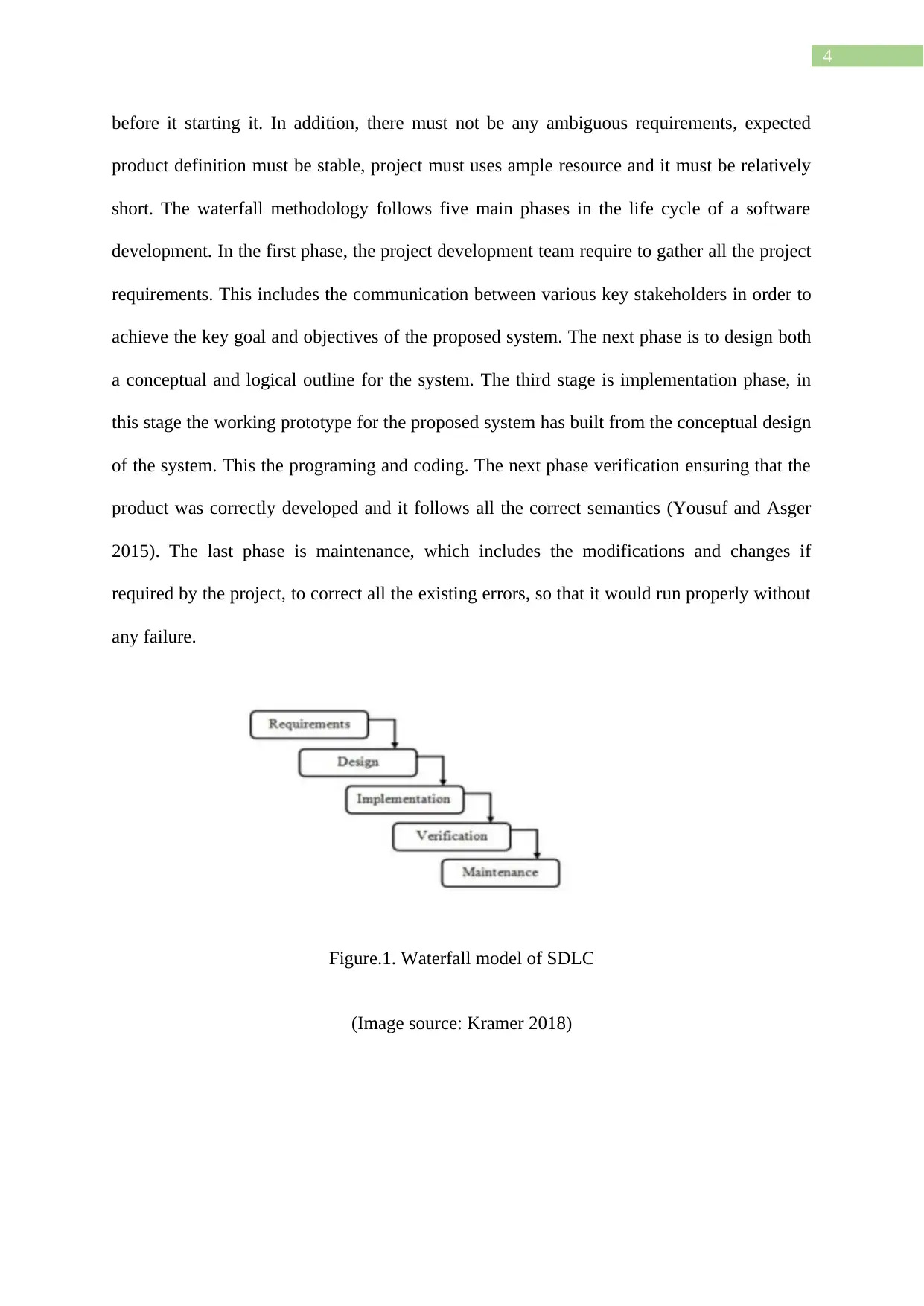
4
before it starting it. In addition, there must not be any ambiguous requirements, expected
product definition must be stable, project must uses ample resource and it must be relatively
short. The waterfall methodology follows five main phases in the life cycle of a software
development. In the first phase, the project development team require to gather all the project
requirements. This includes the communication between various key stakeholders in order to
achieve the key goal and objectives of the proposed system. The next phase is to design both
a conceptual and logical outline for the system. The third stage is implementation phase, in
this stage the working prototype for the proposed system has built from the conceptual design
of the system. This the programing and coding. The next phase verification ensuring that the
product was correctly developed and it follows all the correct semantics (Yousuf and Asger
2015). The last phase is maintenance, which includes the modifications and changes if
required by the project, to correct all the existing errors, so that it would run properly without
any failure.
Figure.1. Waterfall model of SDLC
(Image source: Kramer 2018)
before it starting it. In addition, there must not be any ambiguous requirements, expected
product definition must be stable, project must uses ample resource and it must be relatively
short. The waterfall methodology follows five main phases in the life cycle of a software
development. In the first phase, the project development team require to gather all the project
requirements. This includes the communication between various key stakeholders in order to
achieve the key goal and objectives of the proposed system. The next phase is to design both
a conceptual and logical outline for the system. The third stage is implementation phase, in
this stage the working prototype for the proposed system has built from the conceptual design
of the system. This the programing and coding. The next phase verification ensuring that the
product was correctly developed and it follows all the correct semantics (Yousuf and Asger
2015). The last phase is maintenance, which includes the modifications and changes if
required by the project, to correct all the existing errors, so that it would run properly without
any failure.
Figure.1. Waterfall model of SDLC
(Image source: Kramer 2018)
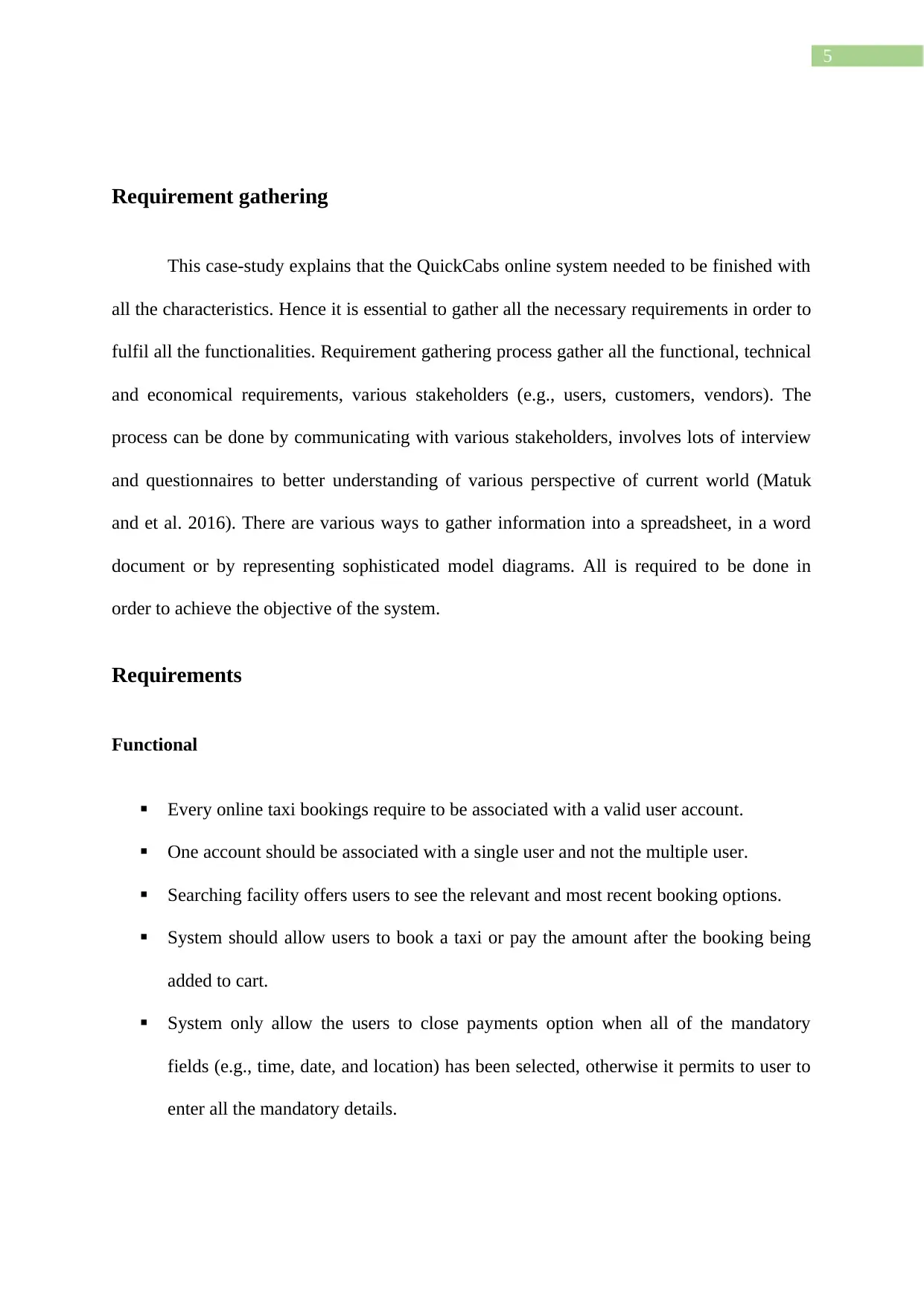
5
Requirement gathering
This case-study explains that the QuickCabs online system needed to be finished with
all the characteristics. Hence it is essential to gather all the necessary requirements in order to
fulfil all the functionalities. Requirement gathering process gather all the functional, technical
and economical requirements, various stakeholders (e.g., users, customers, vendors). The
process can be done by communicating with various stakeholders, involves lots of interview
and questionnaires to better understanding of various perspective of current world (Matuk
and et al. 2016). There are various ways to gather information into a spreadsheet, in a word
document or by representing sophisticated model diagrams. All is required to be done in
order to achieve the objective of the system.
Requirements
Functional
Every online taxi bookings require to be associated with a valid user account.
One account should be associated with a single user and not the multiple user.
Searching facility offers users to see the relevant and most recent booking options.
System should allow users to book a taxi or pay the amount after the booking being
added to cart.
System only allow the users to close payments option when all of the mandatory
fields (e.g., time, date, and location) has been selected, otherwise it permits to user to
enter all the mandatory details.
Requirement gathering
This case-study explains that the QuickCabs online system needed to be finished with
all the characteristics. Hence it is essential to gather all the necessary requirements in order to
fulfil all the functionalities. Requirement gathering process gather all the functional, technical
and economical requirements, various stakeholders (e.g., users, customers, vendors). The
process can be done by communicating with various stakeholders, involves lots of interview
and questionnaires to better understanding of various perspective of current world (Matuk
and et al. 2016). There are various ways to gather information into a spreadsheet, in a word
document or by representing sophisticated model diagrams. All is required to be done in
order to achieve the objective of the system.
Requirements
Functional
Every online taxi bookings require to be associated with a valid user account.
One account should be associated with a single user and not the multiple user.
Searching facility offers users to see the relevant and most recent booking options.
System should allow users to book a taxi or pay the amount after the booking being
added to cart.
System only allow the users to close payments option when all of the mandatory
fields (e.g., time, date, and location) has been selected, otherwise it permits to user to
enter all the mandatory details.
⊘ This is a preview!⊘
Do you want full access?
Subscribe today to unlock all pages.

Trusted by 1+ million students worldwide
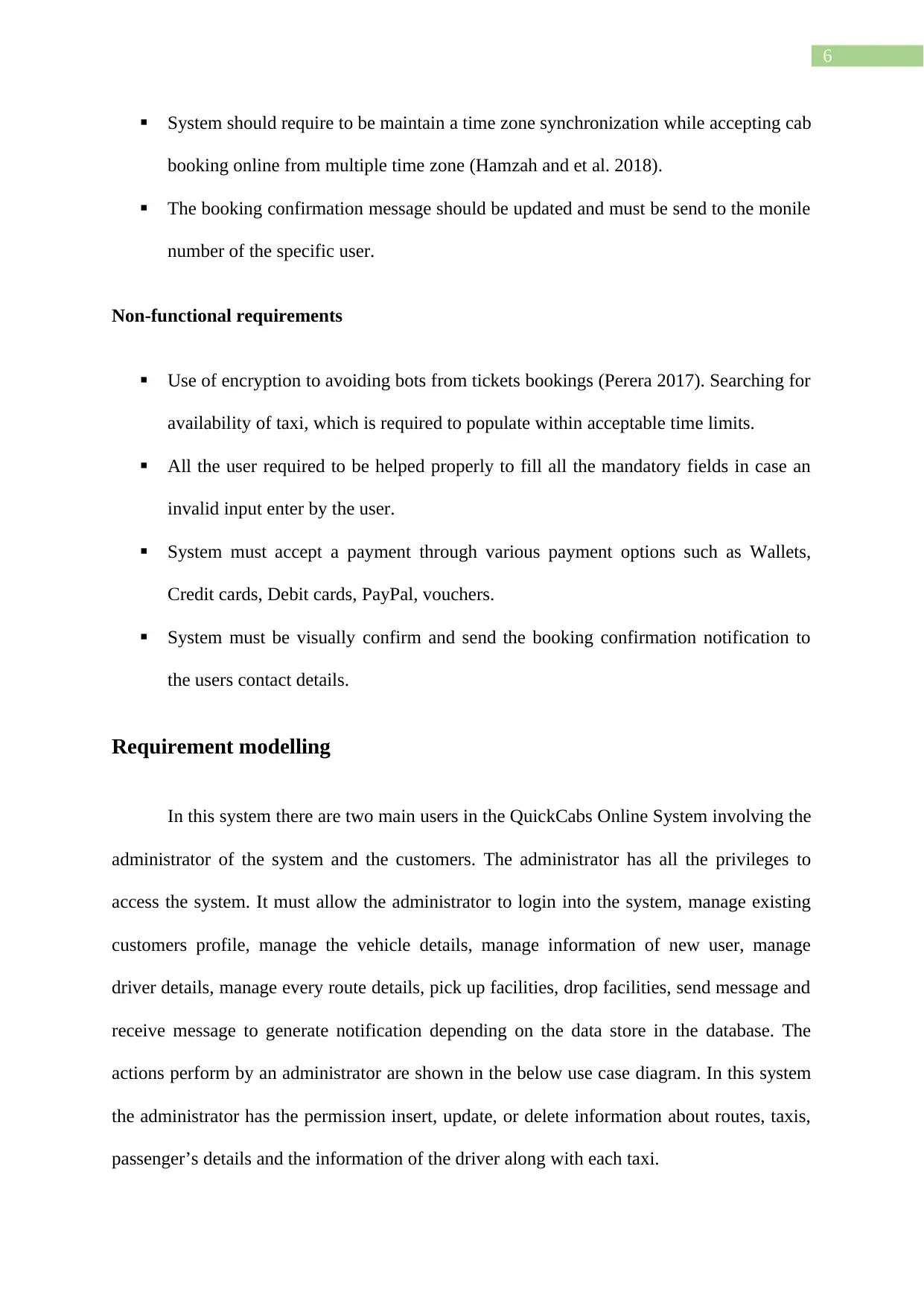
6
System should require to be maintain a time zone synchronization while accepting cab
booking online from multiple time zone (Hamzah and et al. 2018).
The booking confirmation message should be updated and must be send to the monile
number of the specific user.
Non-functional requirements
Use of encryption to avoiding bots from tickets bookings (Perera 2017). Searching for
availability of taxi, which is required to populate within acceptable time limits.
All the user required to be helped properly to fill all the mandatory fields in case an
invalid input enter by the user.
System must accept a payment through various payment options such as Wallets,
Credit cards, Debit cards, PayPal, vouchers.
System must be visually confirm and send the booking confirmation notification to
the users contact details.
Requirement modelling
In this system there are two main users in the QuickCabs Online System involving the
administrator of the system and the customers. The administrator has all the privileges to
access the system. It must allow the administrator to login into the system, manage existing
customers profile, manage the vehicle details, manage information of new user, manage
driver details, manage every route details, pick up facilities, drop facilities, send message and
receive message to generate notification depending on the data store in the database. The
actions perform by an administrator are shown in the below use case diagram. In this system
the administrator has the permission insert, update, or delete information about routes, taxis,
passenger’s details and the information of the driver along with each taxi.
System should require to be maintain a time zone synchronization while accepting cab
booking online from multiple time zone (Hamzah and et al. 2018).
The booking confirmation message should be updated and must be send to the monile
number of the specific user.
Non-functional requirements
Use of encryption to avoiding bots from tickets bookings (Perera 2017). Searching for
availability of taxi, which is required to populate within acceptable time limits.
All the user required to be helped properly to fill all the mandatory fields in case an
invalid input enter by the user.
System must accept a payment through various payment options such as Wallets,
Credit cards, Debit cards, PayPal, vouchers.
System must be visually confirm and send the booking confirmation notification to
the users contact details.
Requirement modelling
In this system there are two main users in the QuickCabs Online System involving the
administrator of the system and the customers. The administrator has all the privileges to
access the system. It must allow the administrator to login into the system, manage existing
customers profile, manage the vehicle details, manage information of new user, manage
driver details, manage every route details, pick up facilities, drop facilities, send message and
receive message to generate notification depending on the data store in the database. The
actions perform by an administrator are shown in the below use case diagram. In this system
the administrator has the permission insert, update, or delete information about routes, taxis,
passenger’s details and the information of the driver along with each taxi.
Paraphrase This Document
Need a fresh take? Get an instant paraphrase of this document with our AI Paraphraser
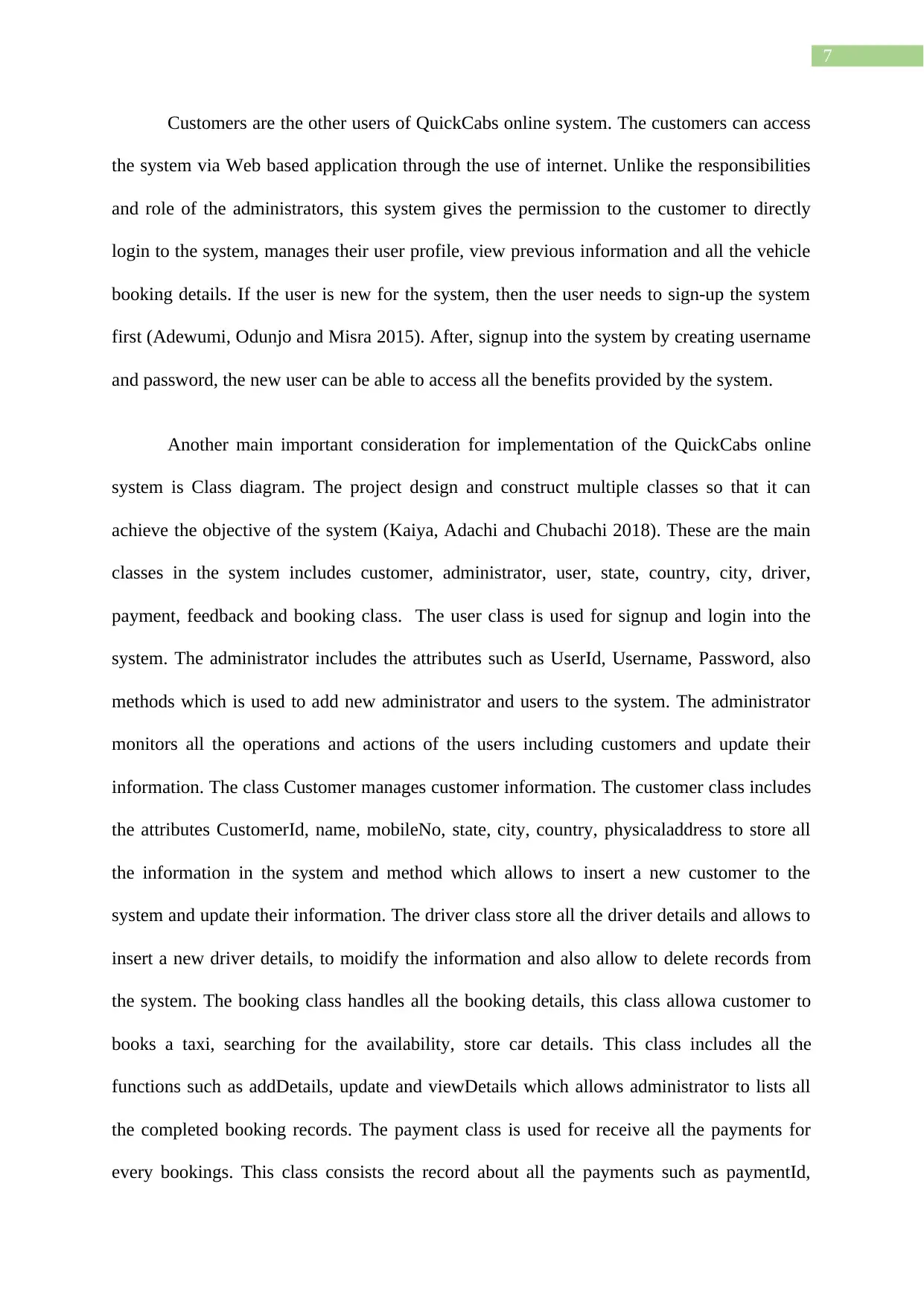
7
Customers are the other users of QuickCabs online system. The customers can access
the system via Web based application through the use of internet. Unlike the responsibilities
and role of the administrators, this system gives the permission to the customer to directly
login to the system, manages their user profile, view previous information and all the vehicle
booking details. If the user is new for the system, then the user needs to sign-up the system
first (Adewumi, Odunjo and Misra 2015). After, signup into the system by creating username
and password, the new user can be able to access all the benefits provided by the system.
Another main important consideration for implementation of the QuickCabs online
system is Class diagram. The project design and construct multiple classes so that it can
achieve the objective of the system (Kaiya, Adachi and Chubachi 2018). These are the main
classes in the system includes customer, administrator, user, state, country, city, driver,
payment, feedback and booking class. The user class is used for signup and login into the
system. The administrator includes the attributes such as UserId, Username, Password, also
methods which is used to add new administrator and users to the system. The administrator
monitors all the operations and actions of the users including customers and update their
information. The class Customer manages customer information. The customer class includes
the attributes CustomerId, name, mobileNo, state, city, country, physicaladdress to store all
the information in the system and method which allows to insert a new customer to the
system and update their information. The driver class store all the driver details and allows to
insert a new driver details, to moidify the information and also allow to delete records from
the system. The booking class handles all the booking details, this class allowa customer to
books a taxi, searching for the availability, store car details. This class includes all the
functions such as addDetails, update and viewDetails which allows administrator to lists all
the completed booking records. The payment class is used for receive all the payments for
every bookings. This class consists the record about all the payments such as paymentId,
Customers are the other users of QuickCabs online system. The customers can access
the system via Web based application through the use of internet. Unlike the responsibilities
and role of the administrators, this system gives the permission to the customer to directly
login to the system, manages their user profile, view previous information and all the vehicle
booking details. If the user is new for the system, then the user needs to sign-up the system
first (Adewumi, Odunjo and Misra 2015). After, signup into the system by creating username
and password, the new user can be able to access all the benefits provided by the system.
Another main important consideration for implementation of the QuickCabs online
system is Class diagram. The project design and construct multiple classes so that it can
achieve the objective of the system (Kaiya, Adachi and Chubachi 2018). These are the main
classes in the system includes customer, administrator, user, state, country, city, driver,
payment, feedback and booking class. The user class is used for signup and login into the
system. The administrator includes the attributes such as UserId, Username, Password, also
methods which is used to add new administrator and users to the system. The administrator
monitors all the operations and actions of the users including customers and update their
information. The class Customer manages customer information. The customer class includes
the attributes CustomerId, name, mobileNo, state, city, country, physicaladdress to store all
the information in the system and method which allows to insert a new customer to the
system and update their information. The driver class store all the driver details and allows to
insert a new driver details, to moidify the information and also allow to delete records from
the system. The booking class handles all the booking details, this class allowa customer to
books a taxi, searching for the availability, store car details. This class includes all the
functions such as addDetails, update and viewDetails which allows administrator to lists all
the completed booking records. The payment class is used for receive all the payments for
every bookings. This class consists the record about all the payments such as paymentId,

8
amount, customerId who made the payemt, total payable amount, and the date of every
transaction.
amount, customerId who made the payemt, total payable amount, and the date of every
transaction.
⊘ This is a preview!⊘
Do you want full access?
Subscribe today to unlock all pages.

Trusted by 1+ million students worldwide
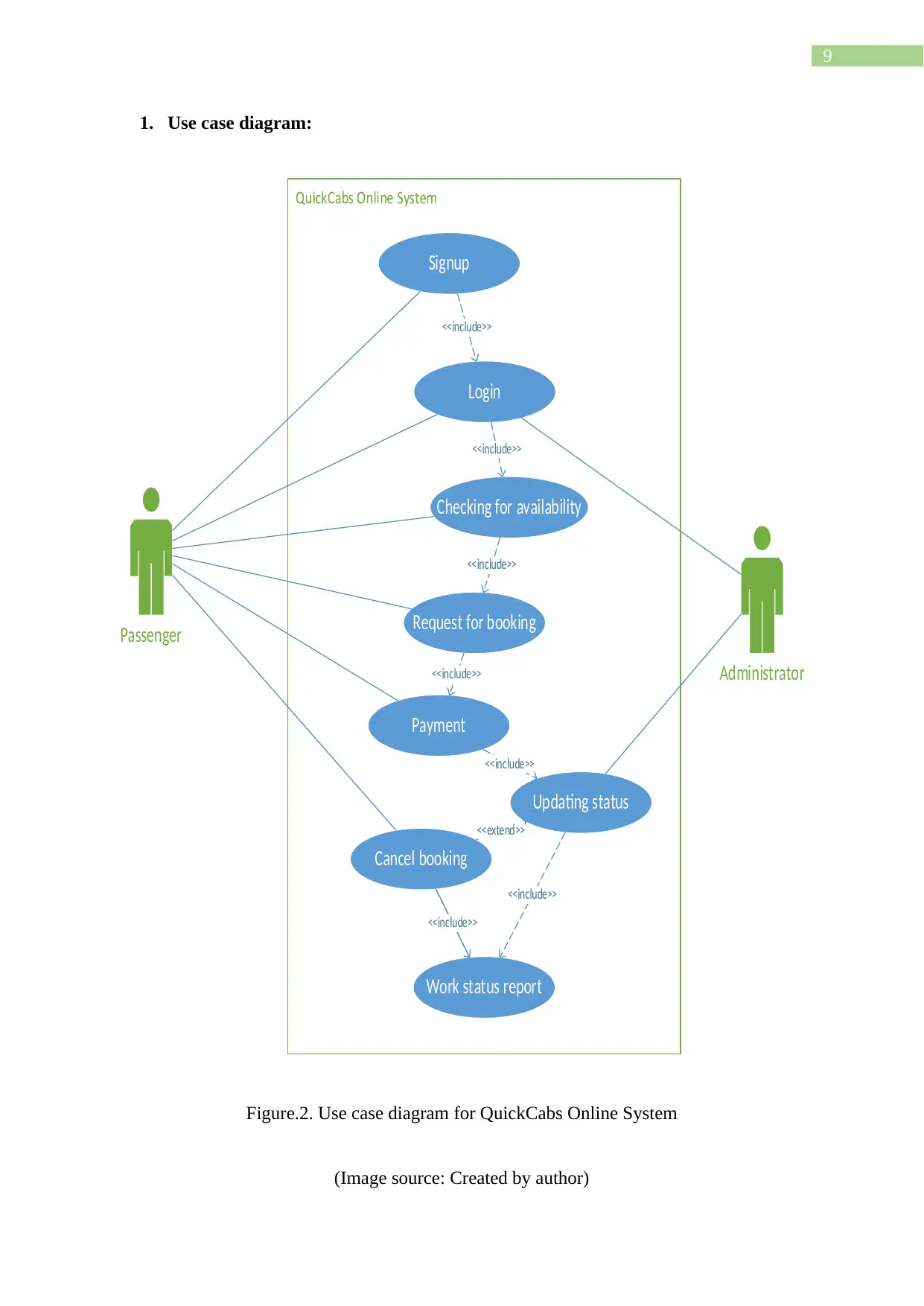
9
1. Use case diagram:
Passenger
Administrator
Login
Checking for availability
Request for booking
Cancel booking
Updating status
Work status report
<<include>>
Signup
<<include>>
Payment
<<extend>>
<<include>>
<<include>>
<<include>>
<<include>>
<<include>>
Figure.2. Use case diagram for QuickCabs Online System
(Image source: Created by author)
1. Use case diagram:
Passenger
Administrator
Login
Checking for availability
Request for booking
Cancel booking
Updating status
Work status report
<<include>>
Signup
<<include>>
Payment
<<extend>>
<<include>>
<<include>>
<<include>>
<<include>>
<<include>>
Figure.2. Use case diagram for QuickCabs Online System
(Image source: Created by author)
Paraphrase This Document
Need a fresh take? Get an instant paraphrase of this document with our AI Paraphraser
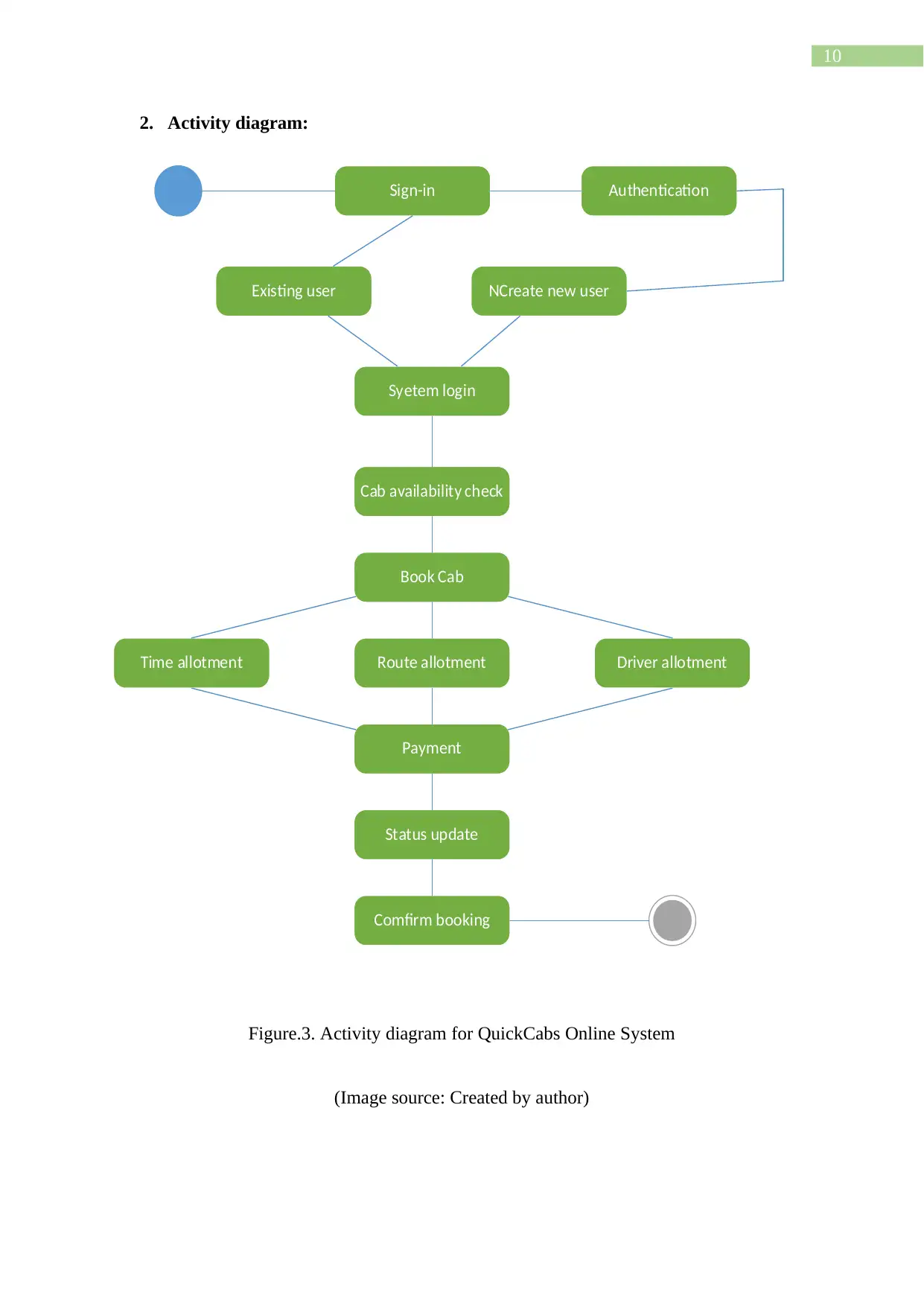
10
2. Activity diagram:
Figure.3. Activity diagram for QuickCabs Online System
(Image source: Created by author)
Sign-in
Syetem login
Existing user NCreate new user
Cab availability check
Book Cab
Authentication
Time allotment Driver allotment
Payment
Status update
Comfirm booking
Route allotment
2. Activity diagram:
Figure.3. Activity diagram for QuickCabs Online System
(Image source: Created by author)
Sign-in
Syetem login
Existing user NCreate new user
Cab availability check
Book Cab
Authentication
Time allotment Driver allotment
Payment
Status update
Comfirm booking
Route allotment
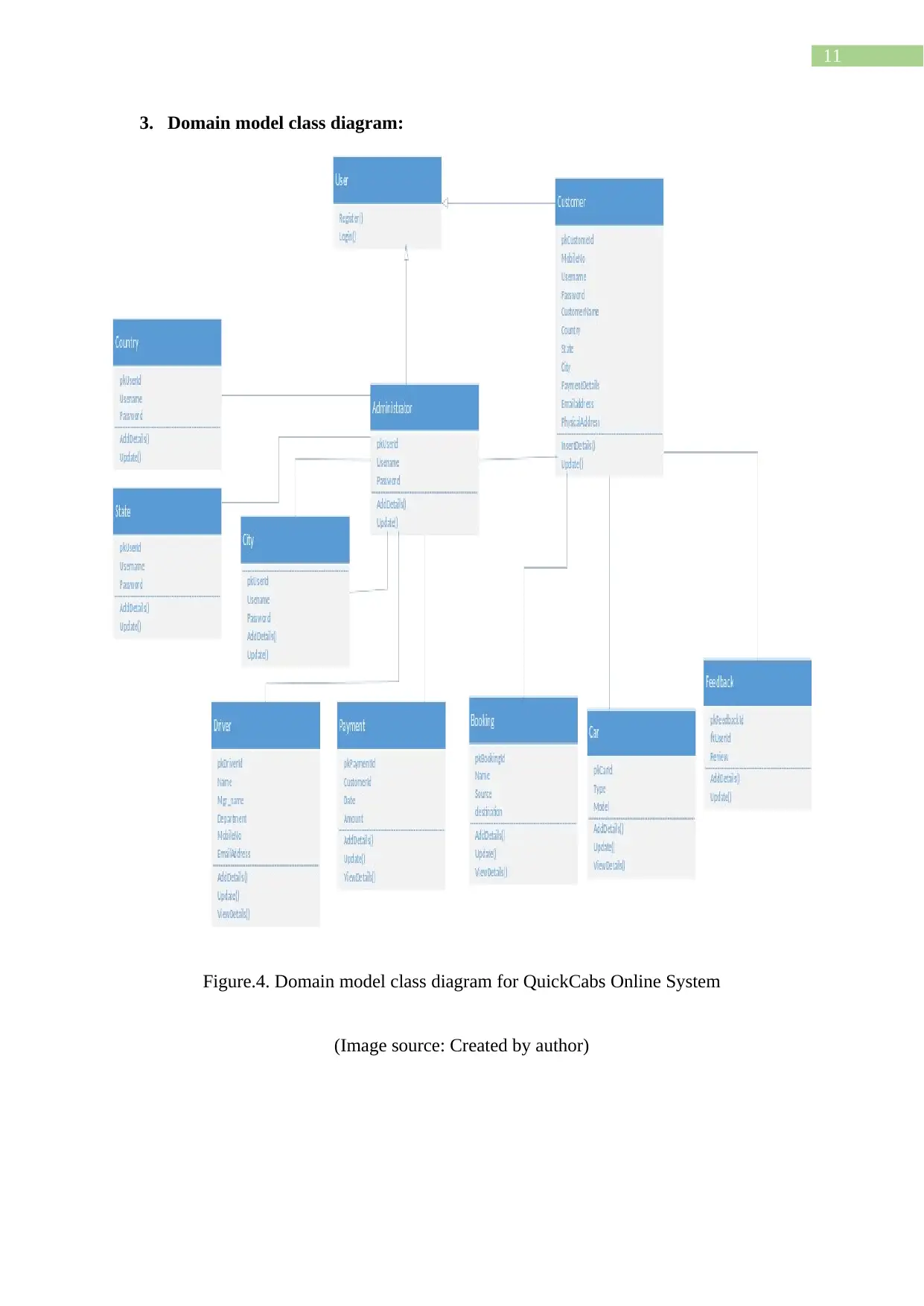
11
3. Domain model class diagram:
Figure.4. Domain model class diagram for QuickCabs Online System
(Image source: Created by author)
3. Domain model class diagram:
Figure.4. Domain model class diagram for QuickCabs Online System
(Image source: Created by author)
⊘ This is a preview!⊘
Do you want full access?
Subscribe today to unlock all pages.

Trusted by 1+ million students worldwide
1 out of 18
Related Documents
Your All-in-One AI-Powered Toolkit for Academic Success.
+13062052269
info@desklib.com
Available 24*7 on WhatsApp / Email
![[object Object]](/_next/static/media/star-bottom.7253800d.svg)
Unlock your academic potential
Copyright © 2020–2025 A2Z Services. All Rights Reserved. Developed and managed by ZUCOL.





